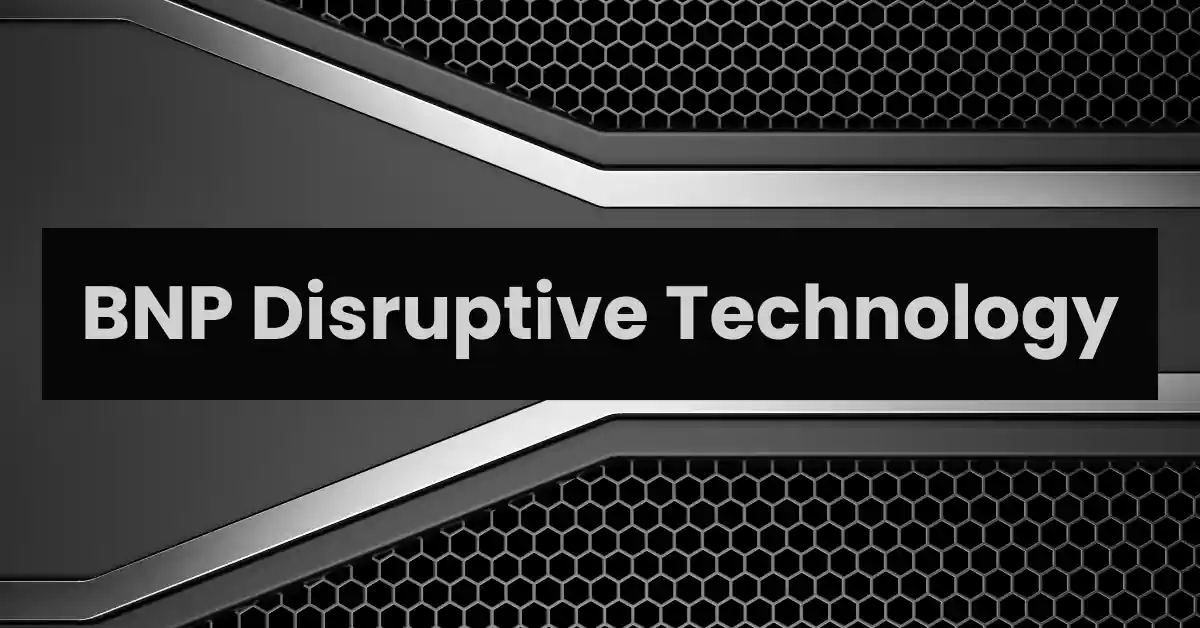In the ever-evolving landscape of technology, a term that often crops up is “disruptive technology.” Specifically, BNP (Bharat Nirmaan Project) disruptive technology is at the forefront of innovation, redefining industries and altering the way we interact with the world around us. Whether you’re a tech enthusiast or a casual observer, understanding BNP disruptive technology can provide valuable insights into the future of various sectors.
Table of Contents
ToggleUnderstanding Disruptive Technology
What is Disruptive Technology?
To begin with, disruptive technology refers to innovations that significantly alter or create new markets, thereby displacing established technologies and companies. Think of it as a wave that can completely reshape the landscape. For example, smartphones have disrupted traditional mobile phones, while streaming services have transformed cable television.
The Role of BNP in Technology Disruption
Moreover, BNP acts as a catalyst in this disruptive journey, focusing on leveraging cutting-edge technologies to foster economic growth and improve living standards. In essence, it aims to bridge the gap between technology and accessibility, making innovations available to a broader audience. Therefore, BNP is not just about technology for technology’s sake; it’s fundamentally about making meaningful changes in people’s lives.
Key Components of BNP Disruptive Technology
Innovations Driving Change
At the heart of BNP disruptive technology are several key innovations, which include:
- Artificial Intelligence (AI): AI is transforming how businesses operate, from predictive analytics in finance to personalized medicine in healthcare.
- Blockchain: This technology enhances security and transparency, significantly impacting sectors like finance and supply chain management.
- Internet of Things (IoT): IoT connects devices, leading to smarter homes and cities, ultimately improving efficiency and convenience.
Examples of BNP Disruptive Technologies
Furthermore, BNP showcases a variety of disruptive technologies, such as:
- Digital Payment Systems: These systems are changing how transactions are conducted, making them faster and more secure.
- Telemedicine: Especially relevant in recent times, telemedicine allows patients to consult with healthcare professionals remotely.
- E-Governance Platforms: These platforms enable citizens to access government services more easily and transparently.
Impact of BNP Disruptive Technology on Industries
Financial Services
In addition, the financial sector is experiencing a significant transformation due to BNP disruptive technology. Traditional banking is being challenged by fintech innovations that offer faster, more convenient services. For instance, mobile banking applications allow users to conduct transactions without visiting a bank branch, thus making financial services more accessible.
Healthcare Sector
Moreover, in healthcare, BNP disruptive technology is improving patient outcomes through innovations like telemedicine and wearable health devices. Now, patients can monitor their health from home and consult doctors via video calls, effectively reducing the burden on healthcare facilities.
Telecommunications
Additionally, telecommunications is another sector experiencing disruption. The advent of 5G technology, fueled by BNP initiatives, enables faster and more reliable connectivity, paving the way for advancements in IoT and smart cities.
Challenges Associated with BNP Disruptive Technology
Regulatory Hurdles
While BNP disruptive technology brings many benefits, it also faces challenges, particularly regarding regulation. Consequently, governments must create policies that foster innovation while ensuring consumer protection and fair competition. Navigating these regulatory landscapes can be a daunting task for emerging technologies.
Market Adaptation
On another note, adapting to new technologies is not always seamless. Companies must be willing to invest in training and infrastructure to keep pace with rapid technological advancements. This, however, can be particularly challenging for smaller businesses with limited resources.
The Future of BNP Disruptive Technology
Emerging Trends
As we look to the future, several trends are emerging within the realm of technology. From advancements in AI and machine learning to the continued growth of blockchain applications, the next decade promises significant changes across various industries.
Predictions for the Next Decade
Experts predict that it will further revolutionize our lives. For instance, we might see enhanced personalization in services, greater automation across sectors, and an even more connected world through IoT. Therefore, businesses that embrace these changes will likely thrive, while those that resist may struggle to keep pace.
Conclusion
In summary, it is more than just a buzzword; it represents a transformative force reshaping our economy and society. As we continue to innovate and adapt, understanding these technologies will be crucial for businesses and individuals alike. Whether you’re an entrepreneur looking to leverage new tools or a consumer navigating this digital age, embracing BNP disruptive technology is undoubtedly the way forward.
FAQs
What is BNP technology?
BNP technology refers to innovations driven by the Bharat Nirmaan Project, focusing on disruptive technologies that promote economic growth and accessibility.
How does BNP technology disrupt traditional markets?
It introduces new products and services that challenge established businesses, often providing better, faster, and more cost-effective solutions.
What industries are most affected by BNP technology?
Industries like finance, healthcare, and telecommunications are significantly impacted, as they adapt to new technologies and changing consumer behaviors.
What are the risks associated with BNP technology?
Risks include regulatory challenges, market adaptation issues, and potential job displacement due to automation.
How can businesses adapt to it?
Businesses can adapt by investing in training, embracing innovation, and staying informed about emerging trends and technologies.






